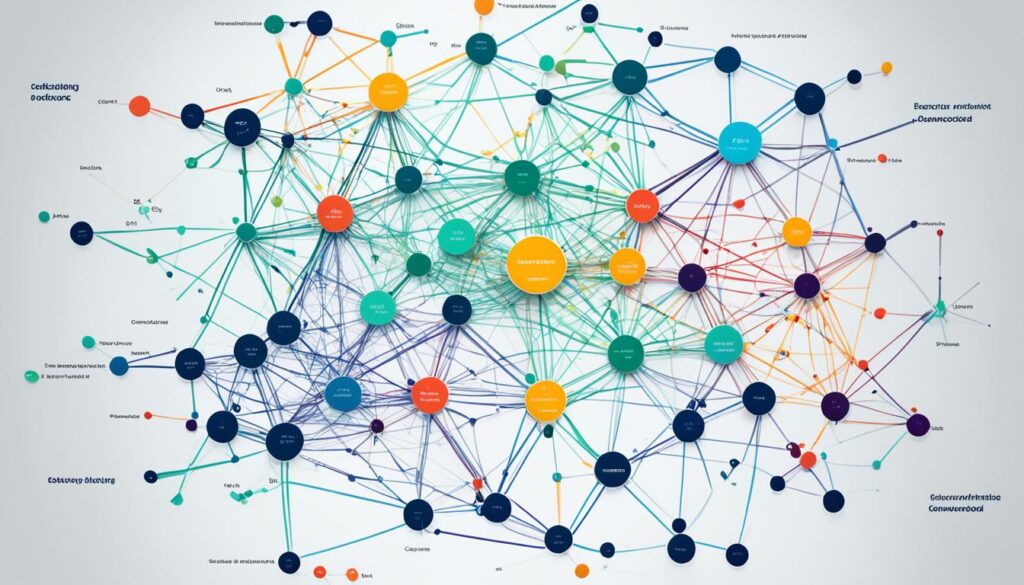How can small and medium-sized enterprises (SMEs) use AI to improve their data analysis without spending too much? AI can help SMEs analyze data better and make smarter decisions without the huge costs often seen with this technology.
Artificial Intelligence (AI) is changing the game for SMEs again. Thanks to better machine learning, more available data, and stronger computers, AI tools are easier to get and cheaper than before1. Now, AI helps SMEs work more efficiently, respond faster, and make better choices without breaking the bank1. These AI systems, which use stuff like sensors and special software, automate hard tasks and give insights based on up-to-the-minute data1.
Still, using AI can be tough, with big differences in how much it’s used across industries and business sizes1. SMEs often struggle because they’re not used to using data, don’t know much about AI’s perks, worry about costs, and fear risks to their reputation and legal issues1. Many businesses worldwide don’t use data analysis enough, showing we need to do more to help and make AI more inclusive1.
Key Takeaways
- AI is increasingly accessible to SMEs, offering transformative capabilities in data analytics.
- SMEs can optimize productivity and enhance decision-making with advanced AI systems.
- The adoption of AI in SMEs varies widely across sectors, necessitating tailored support strategies.
- Barriers to AI adoption include lack of data culture and concerns about costs and risks.
- Increased data availability and computational power have democratized AI applications.
The Role of AI in Modern Data Analytics
Artificial Intelligence (AI) is changing the game for small and medium businesses (SMEs). It helps them work smarter and stay ahead in the market. AI improves how SMEs function by making operations more efficient and driving decisions based on data. It uses machine learning, predictions, and recognizing patterns to do this.
Breaking Down AI Components
In data analytics, AI includes sensors, logic, and actuators. With machine learning, it can sift through big data fast. This lets SMEs handle complex jobs better and boost their work output. Data from various places like sales, social media, and surveys are more easily put together, thanks to AI2.
Predictive modeling forecasts market trends and what customers want2. This helps SMEs make choices that are backed by solid data.
Benefits of AI Over Traditional Analytics
AI has many perks over old-school analytics, especially for resource-tight SMEs. It cuts down costs for making predictions. This helps in pinpointing market groups and sparks new ideas1. AI spots patterns in big data that give deep insights into customer habits and market changes3.
Thus, SMEs can make custom reports and fine-tune their operations, improving their place in the industry2. AI also deals with repetitive tasks, freeing up firms to focus on main goals. This step-up in productivity is a big plus for businesses1.
How AI-Driven Insights Enhance Decision Making
AI is changing how small and medium enterprises (SMEs) make decisions. It speeds up and improves data handling. Advanced analytics and machine learning help in automating tasks, spotting odd patterns, and predicting future events from past data. This gives SMEs valuable insights for planning4.
Speed and Efficiency in Data Processing
AI’s big win is real-time data analysis. This lets SMEs quickly make sense of lots of raw data4. Tools like ChatGPT and MidJourney are great but need fine-tuning for best results4. Fast analysis helps businesses keep up with market changes and customer needs. This keeps them ahead in the competition4.
Actionable Insights from Raw Data
AI uses tools like NLP and computer vision to help SMEs get valuable insights from unstructured data4. Predictive analytics can foresee market trends and improve operations. This betters the decision-making process4. Even simple analytics solutions can offer SMEs clear insights, making reporting and strategic decisions easier4.
AI Data Analytics in Marketing Strategies
AI data analytics is now key for small and medium enterprises (SMEs) wanting better marketing strategies. It uses predictive modeling to divide the market with precision. This lets them tailor their campaigns for specific groups, boosting engagement and conversion rates.
Customer Behavior Analysis
AI helps SMEs get a deep dive into what consumers like and follow. With machine learning, they can analyze big data for predictive analytics and understand feelings5. This knowledge helps predict and meet customer needs, leading to more tailored marketing efforts.
Personalized Marketing Campaigns
AI gives small businesses the tools to send marketing messages that really speak to individuals6. It fine-tunes market segments for better, personalized marketing efforts. Plus, AI algorithms fine-tune online ads in real-time, ensuring money is well-spent6.
When AI is used right, it turns data into valuable insights for smarter marketing decisions7.
Applications of AI in Predictive Modeling
Small and medium enterprises (SMEs) are now using AI for better forecasting. This helps them lead in a tough market. Predictive modeling lets SMEs see future market trends, improve operations, and make smarter decisions.
Anticipating Market Trends
AI helps SMEs guess future market movements and make better business plans. AI looks at a lot of data to find patterns and connections. This is key to staying competitive4. SMEs can adjust their strategies based on what’s coming, staying agile4.
With AI, companies understand customer behaviors and likes better. This leads to smarter marketing and product ideas4.
Risk Management Through Predictive Analytics
AI models also help manage risks well. For example, they can spot odd patterns and foresee results by looking at past data. This cuts down unexpected business problems4. Predictive maintenance models let SMEs plan maintenance ahead, reducing stops and boosting productivity4.
This makes the best use of resources and keeps operations smooth.
Google Analytics lets SMEs watch and study how customers act immediately. This means they can quickly tweak their strategies4. So, using AI in predictive analytics is vital for SMEs to better manage risks and stay competitive.

To wrap up, AI in predictive modeling gives SMEs big benefits in predicting market trends and risk management. By using predictive analytics, businesses can make their operations smoother and grow steadily in a changing market.
Accessibility of AI Tools for SMEs
AI tools are now easier for SMEs to use, thanks to affordable options like SaaS and MLaaS platforms. These options allow SMEs to use advanced AI without big initial costs. Governments also help SMEs handle online risks and use data well1
AI as a Cost-Effective Solution
AI can do many tasks, making SMEs more productive while saving money1. This is great for small businesses working with less money. The McKinsey Global Institute thinks AI could make the whole world 1.4% more productive every year. This means big savings and better use of resources for small companies8.
Software as a Service (SaaS) and AI
SaaS and MLaaS let SMEs grow by providing AI skills and top tools easily1. These platforms keep data safe without needing lots of tech knowledge. But, we must still solve issues like who owns the data and how good internet access needs to be. Investing well in AI is also essential for SMEs to stay ahead of the competition1.
Enhancing Customer Understanding with AI
In today’s competitive market, knowing what customers want and do is key for small and medium businesses. AI-driven analytics offer great help in understanding customers better through tools like behavioral analytics and sentiment analysis.
Behavioral Analytics
Behavioral analytics looks at how customers act across different spots to find useful insights. Companies like Amazon use AI to study how each customer behaves, what they buy, and their trends. This makes the shopping experience better and boosts sales9. AI-powered CRM systems help collect data automatically and give smart insights. This makes customer talks better and creates offers that match what patterns show9. Also, small and medium businesses can use behavioral analytics to improve how they connect and give customers what they really want10.

Sentiment Analysis
Sentiment analysis is key in knowing how customers feel from their feedback. AI-driven sentiment analysis helps businesses understand how people feel about their brand, products, and services. Big companies use AI to make customer service better, offering more personalized and digital experiences9. For example, Starbucks uses AI and predictive analytics with Deep Brew. They make marketing messages more personal and boost customer loyalty, which betters customer experiences9. Looking ahead, emotion AI could understand and react to human feelings. This would make responses more sympathetic and improve how customers are treated9.
AI Data Analytics for SMEs
AI data analytics is key for small and medium businesses, offering them a chance to grow and innovate. Advances in AI mean these businesses can now use tools once only big companies could. With AI, they can understand data better to make smart decisions, improve how they work, and discover new chances in the market1.
Generative AI is great for automating complex data analysis. It helps small businesses get insights fast and affordably. This tech can quickly handle lots of data, showing trends, customer likes, and areas to get better111. Being quick to respond is essential in today’s fast-moving markets.
But there’s more AI can do for small businesses. It’s great for splitting the market into segments and predicting trends. This makes it easier for businesses to offer exactly what customers want12. AI makes predicting cheaper and helps businesses decide what to do next. This way, they can stand out and keep growing.
In today’s world, small businesses need to know how AI can help them compete. AI systems can do complex tasks, allowing businesses to focus on more important work1. This boosts how much they get done and returns on investment by making businesses more agile and responsive.
Adding AI data analytics means using both big and small data. Big data gives deep insights from large info sets, improving customer experiences and work flow112. Small data gives clear, simple insights. For example, it can help plan inventory by looking at weekly sales1112.
So, AI data analytics helps small businesses become more competitive, efficient, and quick to react. By finding the best ways to use generative AI, these businesses can grow and start new things.
Examples of Generative AI Tools for SMEs
Small and medium-sized businesses can use many generative AI tools. These tools help improve operations, customer service, and innovation. They are great for making content, analyzing strategies, and engaging customers.
ChatGPT
ChatGPT is a tool made by OpenAI. It’s known for creating text that sounds like a human wrote it. SMEs can use it to make chatbots, help with writing, translate languages, and summarize texts. This makes customer support and learning better13.
Google Gemini
Google Gemini is another important tool for small and medium businesses. It’s really good at analyzing big data quickly. Combined with Amazon SageMaker, it helps businesses understand trends, predict what customers want, and make their operations better. This leads to smarter decisions and staying ahead of competitors14.

Anthropic Claude 3
Anthropic Claude 3 is a cutting-edge generative AI tool. It’s made for processing language and analyzing data deeply. It aids SMEs in automating tasks, boosting productivity, and making their workflows smoother. Thanks to its advanced NLP and machine learning, work gets easier13.
Streamlining Operations with AI
AI is changing the way SMEs operate, making things more efficient and sparking new possibilities. By handling routine tasks, companies can focus their people on bigger goals. This approach not only ups productivity but also adds more value to the company’s growth. A 2020 Salesforce report suggests SMEs could see a productivity leap of up to 40%15. Also, AI helps in analyzing data and keeping equipment in top shape. This means less downtime and lower costs for keeping things running smoothly16.
Adopting AI helps SMEs find and fill market gaps quicker. It’s becoming essential for companies to use AI to stay competitive15. AI helps make work processes better and prepares SMEs for future challenges. It allows businesses to predict trends more accurately, leading to smarter decisions16.
Before jumping into AI, SMEs should check their tech setup, data, and company culture. Working with experts like No Code District can make this shift smoother15. Building a culture of constant learning keeps companies flexible and forward-thinking15. Embracing AI opens doors for SMEs, offering chances for growth, reaching new markets, and staying ahead of the game16.
The Role of Machine Learning in AI Data Analytics
Machine learning is key in AI data analytics. It helps find patterns and make smart decisions. Small and medium businesses are now using machine learning, big data, and AI. This helps them improve how they work17. With lower storage costs, these businesses can now handle lots of data easily17. This lets them be more competitive.
Machine Learning Algorithms
Machine learning works in two ways: supervised and unsupervised. Supervised learning trains on known data, while unsupervised learning finds new patterns17. These methods have helped businesses a lot. For instance, a boutique boosted sales by 20% by using algorithms for customer suggestions18. A small manufacturer cut costs by 30% with automated inventory management18.
Real-Time Data Analysis
Real-time data analysis with machine learning is key for businesses to react fast. It led to a 15% hike in customer happiness and a 10% revenue increase for a local restaurant chain by optimizing menus18. An agricultural SME increased crop yield by 20% with AI drones checking on crop health18. These examples show how machine learning can transform businesses.
| Industry | Machine Learning Application | Outcome |
|---|---|---|
| Clothing Retail | Customer Purchase Analysis | 20% Increase in Sales18 |
| Manufacturing | Inventory Automation | 30% Reduction in Costs18 |
| Restaurant | Menu Optimization | 15% Increase in Customer Satisfaction, 10% Revenue Boost18 |
| Agriculture | Crop Monitoring with Drones | 20% Increase in Crop Yield18 |
| E-Commerce | AI-Driven Chatbots | 40% Increase in Inquiries, 15% Rise in Sales18 |
In conclusion, businesses can use machine learning for many things. This includes automating tasks and analyzing data in real time. It boosts their competitive edge and efficiency.
Data Visualization Tools Empowered by AI
Data visualization tools like Tableau and Power BI are now powered by AI. They help small and medium businesses make smart dashboards. These show key facts and help in making decisions based on data. Using Tableau, businesses can analyze customer data to see trends. Power BI helps in offering tailored experiences. These tools also keep an eye on what competitors are doing11. They change hard-to-understand data into easy visuals. This makes it simpler for businesses to get and use important info.
Utilizing Tableau and Power BI
Tableau and Power BI are top data visualization tools that use AI for small and medium businesses. With Tableau, businesses can look at data in real-time. This helps them make fast and smart choices. Also, it spots chances for growth using past data11. Power BI has great visualization tools. It lets businesses keep track of how they are doing. For instance, Georgia-Pacific LLC boosted their equipment’s efficiency by 10% with analytics19.
Interactive Dashboards for SMEs
Interactive dashboards with Tableau and Power BI give a full picture of how a business is doing. They make looking at data easier. This helps in understanding complex info and spotting chances to grow. Mixing AI with dashboards helps in making better choices by giving insights based on data11.
This lifts efficiency and productivity by automating tasks. It lets small businesses stay ahead by reacting quickly to changes in the market and what customers want11. Also, firms like Lockheed-Martin Corp. have saved lots of downtime in six months. They did this by using IoT analytics, which works with interactive dashboards19.
| Tool | Features | Use Cases |
|---|---|---|
| Tableau | Real-time analytics, comprehensive visualizations | Growth opportunity identification, efficiency improvements |
| Power BI | Data integration, customizable dashboards | Performance tracking, competitor monitoring |
Challenges and Barriers to AI Adoption in SMEs
AI has much to offer small and medium enterprises (SMEs), but several hurdles stand in the way. This includes a lack of data culture within organizations, high costs, and big investment risks.
Lack of Data Culture
Many SMEs do not have a strong data culture, which is crucial for AI. They face obstacles like not enough awareness and the need for retraining. High costs and unclear returns also play a role1. It’s vital that governments and policymakers work to develop a data-driven mindset. They should offer support to help SMEs establish solid data management practices.
Costs and Investment Risks
For SMEs, the costs and risks of investing in AI are major concerns. Starting with AI requires a big upfront investment in tech and know-how. This can be scary for smaller businesses. Also, AI spreading unevenly across different regions and business sizes raises fears of growing inequality1. It points to the need for support from policymakers. Financial assistance to narrow the investment gap is key.
SMEs can tap into AI expertise from outside through cloud services, like SaaS and MLaaS. These options provide benefits like flexibility, cost savings, and security1. Yet, they also bring issues such as data control questions and the need for reliable internet1. To overcome these hurdles, in-depth industry studies and practical examples are essential. They help tailor the approach to AI, taking into account the unique challenges of different settings1.
AI in Supply Chain Management for SMEs
Small and medium-sized businesses use AI to make supply chain management better. AI helps with everything from improving logistics to managing inventory in new ways. This leads to doing things more efficiently and cutting costs420.
Optimizing Logistics with AI
AI tools help make the supply chain clearer and show how suppliers are doing. Knowing this helps with managing inventory right on time20. SMEs find that AI makes working with suppliers easier and more responsive. It also helps plan for things like worker strikes or bad weather affecting supplies20.
Inventory Management Solutions
AI gives SMEs advanced ways to handle their inventory, keeping just the right amount of stock. It predicts how much product will be needed, so there’s no overstocking or running out4. AI lets SMEs see sales trends and customer habits, helping improve inventory plans and work more efficiently4. AI’s neural networks make decisions like a human would but are always learning from new information, making sure products are restocked right and on time20.
- Enhanced supplier performance monitoring with AI20
- Automated labor disruption predictions20
- Demand forecasting through predictive analytics4
- Reduction in overstocking and stockouts4
- Continuous adaptation to new data inputs with neural networks20
Using AI makes supply chain management easier for SMEs, improving both logistics and inventory strategies. This builds a strong base for future growth and success420.
| Benefit | Description |
|---|---|
| Supplier Performance Monitoring | AI provides deeper visibility into supplier performance with immediate feedback on progress and performance20 |
| Labor Disruption Predictions | Predicting potential labor disruptions like union contract renewals through AI20 |
| Demand Forecasting | Enhanced demand forecasting using predictive analytics, reducing overstocking and stockouts4 |
| Continuous Learning | Neural networks continuously adapt to new data, ensuring accurate and timely restocking20 |
Leveraging AI for Competitive Advantage
Small and medium-sized enterprises (SMEs) can gain a big edge by using AI. It lets them excel in understanding customers and creating new products. AI helps them get to know their customers well, make operations smoother, and create innovations faster.
Market Segmentation and Targeting
AI helps SMEs dig into big data to spot different customer groups. This means they can design marketing that really speaks to these groups. Nearly all leading companies are already putting money into AI to boost their marketing strategies21. This tech makes marketing more effective, increasing customer interest and sales.
Innovation and Product Development
AI is changing the game in innovation and making new things. It’s expected to grow to $1.81 trillion by 2030, showing how big its impact is21. It could add $15.7 trillion to the economy by 2030, helping businesses create faster and at lower costs21. SMEs can use AI to make their research and development smoother, speed up bringing products to market, and deliver new things customers want.
By using AI, SMEs can keep up with big companies and find their own unique strengths. For extra insights and applications, you can check out Business Connect Magazine. Adopting AI changes how SMEs work, opening doors to grow and succeed.
FAQ
What is AI in data analytics for SMEs?
How do AI components break down in modern data analytics?
What advantages does AI offer over traditional analytics?
How does AI improve the speed and efficiency of data processing?
What are actionable insights from raw data generated by AI?
How does AI enhance marketing strategies for SMEs?
What are the applications of AI in predictive modeling for SMEs?
How accessible are AI tools for SMEs?
How does AI help SMEs understand their customers better?
What are some examples of generative AI tools for SMEs?
How can AI streamline operations within SMEs?
What role does machine learning play in AI data analytics?
How do data visualization tools empowered by AI benefit SMEs?
What challenges do SMEs face in adopting AI?
How does AI optimize supply chain management for SMEs?
How can SMEs leverage AI for a competitive advantage?
Source Links
- https://www.oecd-ilibrary.org/sites/01a4ae9d-en/index.html?itemId=/content/component/01a4ae9d-en
- https://gxait.com/business-strategy/predictive-analytics-and-ai-driven-decisions-for-small-and-medium-businesses/
- https://smallbusinesscurrents.com/2023/11/08/unlocking-power-artificial-intelligence-smes/
- https://ioaglobal.org/blog/understanding-distinction-between-ai-and-data-analytics-for-smes/
- https://skills.ai/blog/comparing-big-data-and-small-data-analytics-for-business-insight
- https://www.linkedin.com/pulse/empowering-small-business-success-leveraging-ai-marketing-titu-sarder-egege
- https://www.quantacus.ai/blog/how-ai-is-transforming-marketing-strategies-and-analytics
- https://www.biz2credit.com/blog/ai-for-small-business/
- https://surveysparrow.com/blog/ai-customer-experience/
- https://skills.ai/blog/data-mastery-for-smes-intuitive-analysis-techniques/
- https://www.linkedin.com/pulse/ai-data-analytics-small-businesses-leveraging-insights
- https://skills.ai/blog/comparing-big-data-and-small-data-analytics-for-business-insight/
- https://www.mailmodo.com/guides/ai-tools-for-small-businesses/
- https://aws.amazon.com/blogs/smb/exploring-practical-use-cases-for-generative-ai-in-small-businesses/
- https://nocodedistrict.com/the-power-of-ai-for-smes-a-journey-of-innovation-and-growth/
- https://www.iprimamedia.com/ai-for-smes-unlocking-competitive-advantage/
- https://objectiveit.com/blog/what-is-machine-learning-for-smes/
- https://www.linkedin.com/pulse/artificial-intelligence-machine-learning-transforming-ninsiima
- https://www.sme.org/technologies/articles/2023/june/emerging-data-analytics-tools/
- https://www.sme.org/technologies/articles/2023/september/ai-enabled-supply-chain-optimization/
- https://www.businessconnectmagazine.co.uk/leveraging-ai-for-competitive-advantage-in-smes/



